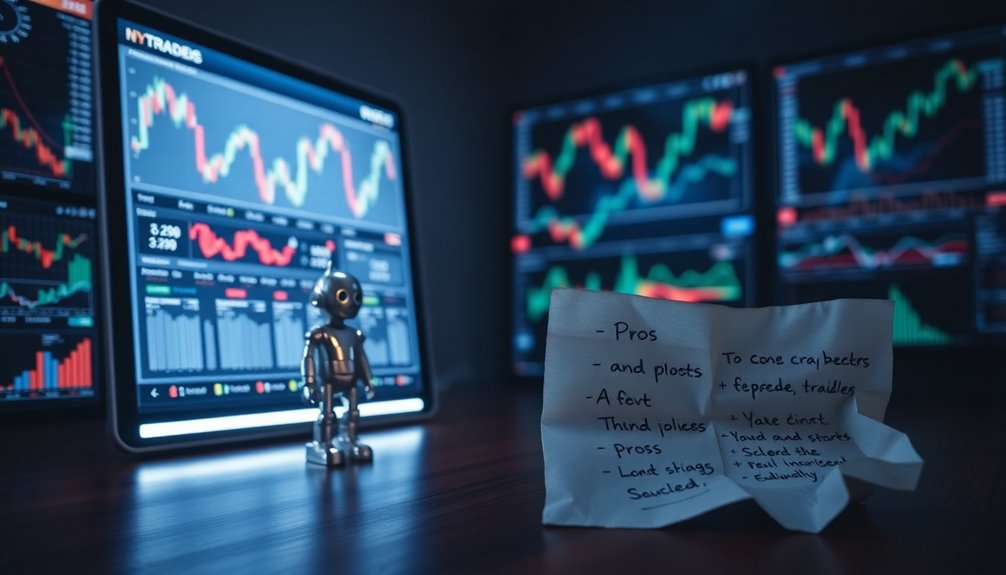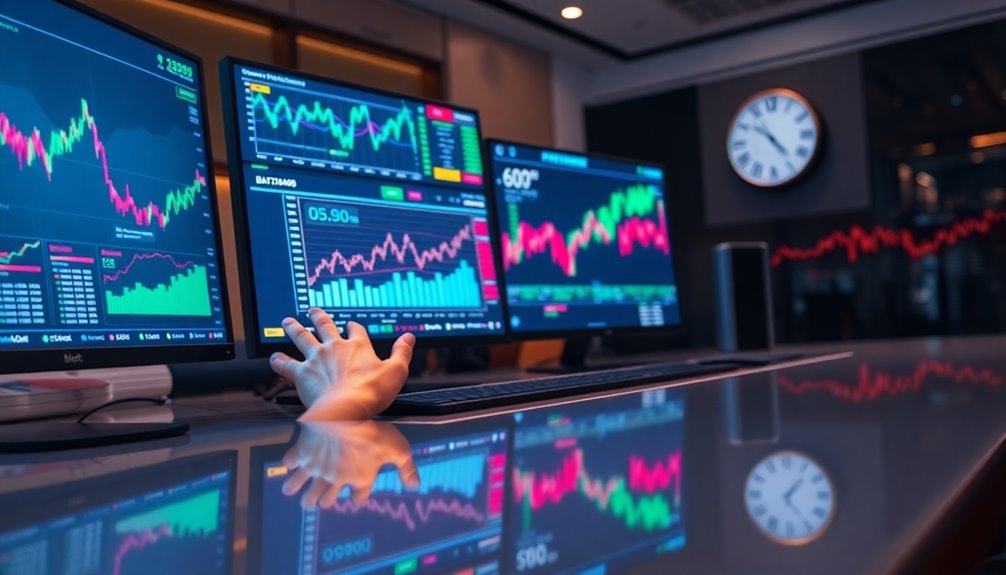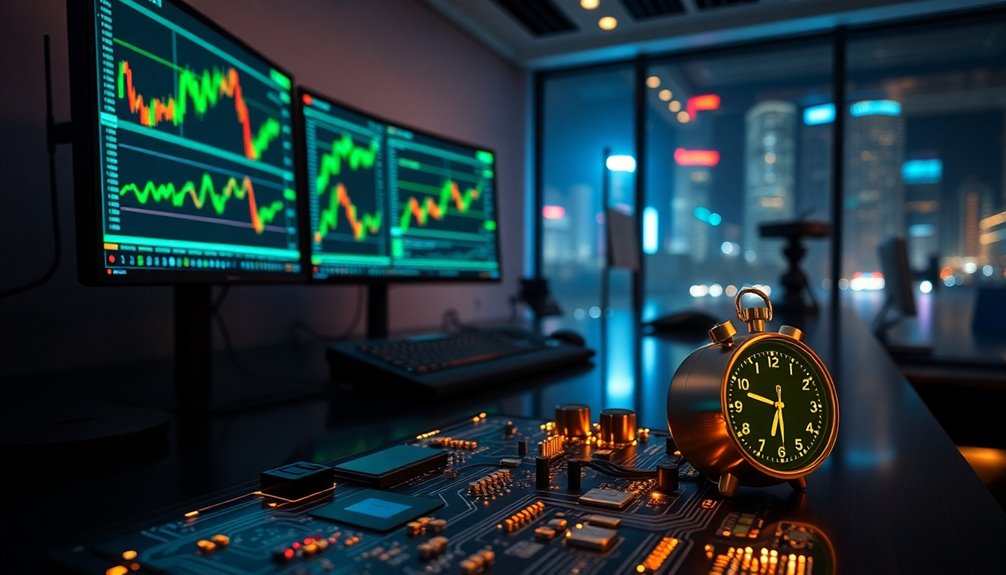Trading bots are automated software that executes trades for you using advanced algorithms. They analyze market data and follow predefined rules, allowing you to take advantage of opportunities without letting emotions get in the way. These bots can operate 24/7, ensuring consistency and efficiency in your trading strategy. You can choose fully automated or semi-automated options, tailored to match your investment goals. While they offer many benefits, it's important to monitor their performance and adapt as market conditions change. If you're curious about how they really work, you'll find more insights ahead.
Key Takeaways
- Trading bots are automated software that execute trades based on predefined rules, minimizing emotional influences on trading decisions.
- They utilize advanced algorithms to analyze market data and operate 24/7 across multiple markets simultaneously.
- Users can choose between fully automated or semi-automated trading options tailored to their investment goals.
- Performance evaluation metrics include win rate, ROI, and risk management ratios like the Sharpe ratio.
- While offering efficiency and consistency, trading bots require ongoing monitoring due to potential technical failures and market adaptability challenges.
Automated Trading Software Overview

Automated trading software acts as your personal trading assistant, leveraging advanced algorithms to make rapid trading decisions.
It uses sophisticated mathematical models and Expert Advisors to automate trades based on predefined rules. By connecting to your brokerage account or a specific trading platform, it can analyze factors like fundamental indicators, news, and volatility in real-time. This software executes trades without human intervention, minimizing emotional impacts on your decisions. Key features include setting conditions for buying and selling, real-time data analysis, and risk management tools like stop-loss orders.
With the ability to track multiple markets simultaneously, automated trading software enhances your speed and efficiency, allowing you to capitalize on market opportunities that human traders might miss. As of 2017, automated systems accounted for 70-85% of all trading activity, highlighting their significant impact on the financial market.
Defining Trading Automation Tools

Trading automation tools are designed to streamline the trading process, making it more efficient and effective for traders of all levels.
These tools consist of algorithms that analyze market data and execute trades through execution systems. You'll benefit from real-time market data feeds that keep you informed about price quotes and historical trends.
Depending on your preference, you can choose fully automated tools that operate independently or semi-automated ones that require your approval before executing trades. Automated tools offer the capability to trade across multiple markets and asset classes simultaneously, enhancing your trading opportunities.
Monitoring tools help you track performance and risk, ensuring your strategies align with your goals.
Additionally, customization options allow you to set specific entry and exit rules, making these tools adaptable to your unique trading style.
Algorithmic Decision-Making Process

As you delve into the algorithmic decision-making process, you'll find that effective trading bots rely heavily on data collection and analysis to inform their actions.
They gather real-time market data, economic indicators, and sentiment analysis, ensuring all information is cleaned and formatted consistently. Based on predefined rules, these bots utilize technical indicators and machine learning models to recognize patterns and predict price movements. Furthermore, they are designed to execute trades automatically, enhancing automated execution capabilities in response to market conditions.
When specific conditions are met, they execute trades instantly to capitalize on opportunities while managing risk through set parameters. Continuous real-time analysis allows them to adapt swiftly, ensuring they make informed decisions.
Ultimately, this automated execution enhances efficiency and accuracy in trading strategies.
Pros and Cons Analysis

Utilizing algorithmic decision-making can greatly enhance your trading experience, but it's important to weigh the advantages and disadvantages of trading bots.
On the plus side, trading bots offer efficiency through immediate trade execution, 24/7 automation, and the ability to analyze vast data. They also ensure consistency, eliminating human bias and allowing for diversification across multiple assets. Additionally, their customizable strategies can align with individual investment goals, providing tailored trading approaches.
However, there are risks involved. Technical failures can lead to significant losses, and bots may struggle to adapt to changing market conditions. You'll need programming skills for customization, and performance can vary due to market shifts.
Ultimately, while trading bots can streamline your trading, they require careful consideration and ongoing monitoring to ensure effectiveness.
Bot Performance Evaluation

Evaluating a trading bot's performance is crucial for maximizing your investment strategy. Start by examining key metrics like accuracy, precision, and recall to understand how well your bot predicts market movements. The quality of your training data is essential for ensuring effective learning for trading bots, as it directly impacts model generalization.
The F1 score helps balance precision and recall, while the win rate indicates the percentage of profitable trades. Don't forget to assess the return on investment (ROI) to measure profitability relative to your initial input. Risk management is equally important; analyze the Sharpe ratio and maximum drawdown to gauge risk-adjusted returns. Implement stop-loss and take-profit orders to protect your capital.
Finally, consider execution speed and backtesting results to ensure your bot operates efficiently and is well-optimized for real market conditions.
Market Volatility Impact

Market volatility significantly impacts trading bots, influencing their strategies and performance. When volatility spikes by 5% or more, bots initiate trades to seize profit opportunities. They analyze price action and leverage historical data to ensure timely entries and exits. By focusing on early-day volatility, bots capitalize on market movements right after opening. Moreover, Tickeron's bots are specifically designed to exploit volatility spikes of 6% or more for optimal trading.
Trading bots enhance market stability by injecting liquidity and preventing extreme price swings. Operating continuously, they help reduce uncertainty among investors. With risk management strategies like stop losses and drawdown management, bots protect your capital in volatile conditions. By employing trend-following and grid trading strategies, they navigate market fluctuations effectively, allowing you to take advantage of rapid changes while minimizing risks.
AI Integration in Trading Bots

As trading environments become increasingly complex, integrating AI into trading bots offers a significant advantage.
AI enables these bots to collect and analyze real-time data, including prices and trading volumes, while factoring in fundamental economics and sentiment data from news and social media.
By using machine learning, trading bots can recognize patterns in historical and current data to forecast trends more accurately. They continuously learn and adapt their strategies based on new data, enhancing decision-making and reducing emotional bias.
Moreover, with the ability to execute trades in real-time and dynamically adjust strategies, AI-integrated trading bots can respond effectively to market changes, improving overall trading performance and risk management. Additionally, these bots utilize predictive analytics to project future market trends, allowing for more informed trading decisions.
Optimize for Low-Latency Execution

To achieve success in high-frequency trading, optimizing for low-latency execution is crucial. Start by minimizing network latency; select co-location facilities near exchange servers and utilize high-speed, low-latency connections. Optimize network protocols to reduce communication delays. Additionally, understanding that market data latency can significantly impact your decision-making speed is essential for maintaining a competitive edge.
Next, invest in high-performance hardware like high-clock-speed CPUs and solid-state drives (SSDs) to enhance processing speed. Streamline your software logic by simplifying execution algorithms and minimizing unnecessary computations.
For order routing, optimize algorithms to pick the fastest execution venues, and subscribe to direct market data feeds to decrease latency. Employ efficient data processing techniques and smart order routing to split large orders across multiple exchanges.
These strategies will help you execute trades swiftly and effectively, maximizing your trading opportunities.
Frequently Asked Questions
Can Trading Bots Be Used for All Asset Classes?
Yes, trading bots can be used for all asset classes. You can utilize them for stocks, commodities, cryptocurrencies, and forex trading.
They analyze real-time market data, economic indicators, and sentiment, allowing you to capitalize on opportunities quickly. With customizable algorithms, you can tailor strategies to fit your trading style.
Plus, their ability to operate 24/7 means you won't miss out on potential trades, enhancing your overall trading experience.
What Is the Cost of Using a Trading Bot?
Imagine you're using a trading bot like 3Commas. The cost varies significantly, with plans starting from $0 for basic features to $59 for advanced tools.
You'll also encounter exchange fees and potential commissions based on your trades. For example, with RevenueBot, you might pay a 20% commission on profits, capped at $50 monthly.
Are Trading Bots Legal in All Countries?
Trading bots aren't necessarily legal in all countries. You need to be aware of each region's regulations, as they vary widely.
In places like the U.S. and EU, strict compliance with financial laws is a must. However, in less regulated markets, the legality can be murky.
Always check local laws to avoid penalties and legal issues. Staying informed will help you navigate the complexities of using trading bots in different jurisdictions.
How Do I Choose the Right Trading Bot?
Choosing the right trading bot involves assessing several key factors.
Start by evaluating the bot's security measures and reputation through user reviews.
Next, consider the costs and any hidden fees associated with its use.
You'll also want to check how user-friendly the interface is and whether it allows for customization to fit your trading style.
Finally, ensure there's reliable customer support and look at the bot's performance metrics to gauge its effectiveness.
Can I Create My Own Trading Bot?
Creating your own trading bot is like crafting a masterpiece; it requires skill and creativity. You can definitely build one!
Start by choosing a programming language that suits your needs, like Python for its powerful libraries. Define your trading strategy, including entry and exit rules, and then write the code to implement it.
Finally, test and optimize your bot using historical data. With dedication, you can develop a trading bot tailored to your trading style!
Conclusion
In summary, trading bots offer a powerful way to navigate the complexities of financial markets. Did you know that over 70% of all trading volume in the U.S. stock market comes from algorithmic trading? This statistic highlights just how prevalent and influential these tools have become. By understanding their benefits and limitations, you can make informed decisions about incorporating them into your trading strategy, ultimately enhancing your potential for success in the market.









